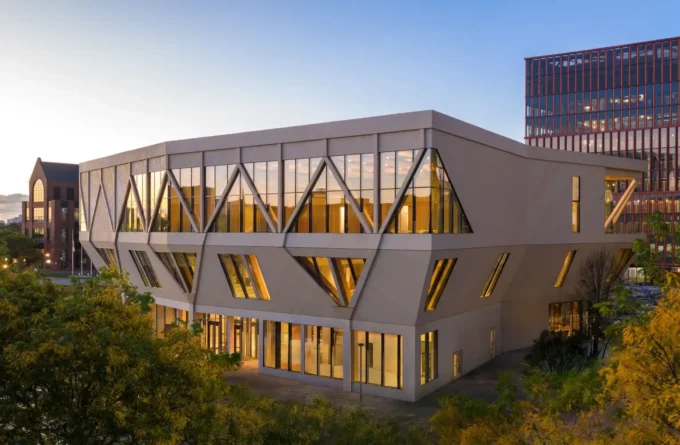The James Cook University Engineering & Innovation Place (EIP) represents a transformative addition to the JCU campus, designed by KIRK Studio, i4 Architecture, and Charles Wright Architects. This multifunctional building is conceived as a hub for engineering, innovation, and collaboration, integrating the Engineering & Innovation Place, Ideas Market, and University Mall into a cohesive spatial framework. The design fosters connectivity and interaction, creating a vibrant focal point for students, academics, and industry partners.
Strategically located at a major gateway on the campus, the EIP occupies a crossroads along the Mount Stuart and Magnetic Island axes, activating these key pedestrian corridors and forming a dynamic campus hub. Its position enhances visibility, accessibility, and integration with the surrounding campus infrastructure.

Next-Generation Learning Spaces
A core feature of the project is its pedagogical innovation. The EIP replaces 20,000m² of traditional learning spaces with 10,000m² of flexible, multi-modal environments designed to encourage social learning, collaboration, and cross-disciplinary interaction.
Multi-Modal Studio (MMS)
The Multi-Modal Studio (MMS) exemplifies this approach, providing a 180-seat flexible studio that accommodates multiple learning modes simultaneously, from didactic lectures to informal group work. The tiered level change enhances visibility and functionality, supporting contemporary pedagogical methods while fostering student engagement and creativity.

Architectural Response to the Tropical Climate
The EIP is tailored to the dry tropical climate, employing passive design strategies that set a new benchmark for sustainable architecture in tropical settings. The building’s dramatic folded-plate parasol roof creates a permeable, transparent façade that promotes natural ventilation, reducing reliance on mechanical cooling systems. This design maximizes air movement in mixed-mode conditions, ensuring thermal comfort while enhancing energy efficiency.
Façade and Material Innovation
The building façade combines hybrid timber glulam (GLT) systems with debris impact-resistant glass, delivering thermal performance and cyclone resilience without conventional protective screens. The design ensures abundant daylighting, which is critical for learning environments, while maintaining protection against tropical hazards.
The Structures Lab features bespoke weathering steel louvers, providing permanent ventilation for double-height spaces. Over time, the oxidizing steel develops a rich, earthy patina, referencing the local landscape and celebrating JCU’s industrial connections. This approach produces a durable, robust, and resilient building envelope that balances permeability and protection.

Sustainability and Environmental Integration
Sustainability is embedded throughout the project via integrated environmental design strategies. Key interventions include:
-
Microclimate improvement through strategic separation of building volumes.
-
Enhanced air circulation across pedestrian pathways and courtyards.
-
Walkable campus connections, encouraging informal interaction and physical activity.
These strategies reduce energy consumption, improve comfort, and strengthen the connection between the built environment and the natural climate, aligning with JCU’s vision for a connected and sustainable campus.

Social and Educational Impact
The EIP functions not only as a building but as a catalyst for campus life, activating public spaces and encouraging cross-disciplinary collaboration. The integration of indoor and outdoor areas, Ideas Market zones, and shared amenities supports informal learning and community engagement. It embodies a forward-thinking approach to university facility design, positioning JCU as a leader in tropical educational architecture.
By combining innovative spatial planning, climate-responsive architecture, and pedagogical flexibility, the EIP enhances the student experience, strengthens academic collaboration, and reinforces JCU’s role as a trailblazer in tropical and sustainable campus design.

Conclusion
The James Cook University Engineering & Innovation Place stands as a model for future educational buildings, demonstrating how flexible, sustainable, and contextually responsive design can support learning, innovation, and community. Through its thoughtful integration of climate-conscious architecture, advanced materials, and collaborative spaces, the EIP sets a precedent for 21st-century university infrastructure, merging pedagogy, sustainability, and social engagement into a unified campus landmark.
Photography: Peter Bennetts
- campus hub design
- Charles Wright Architects
- climate-responsive architecture
- Collaborative learning environments
- cyclone-resilient façade
- Educational architecture
- environmental integration
- Flexible learning spaces
- hybrid timber glulam
- i4 Architecture
- informal learning spaces
- innovative university facilities
- James Cook University – Engineering & Innovation Place
- KIRK Studio
- multi-modal studio
- passive design strategies
- pedestrian-friendly campus
- Sustainable campus design
- Tropical climate architecture
























































Leave a comment